NCHN Blog
Chairs of Network Leadership: Part III - Are you sitting too much on the job?

So, I’m standing here at my desk, thinking about what to write for this month’s article, when I realize that no one sent me a network “chair story” since Mary Ann Watson’s response to the first article. This made me start wondering, if maybe a better article would be “Why do we need chairs?” Are we all sitting too much? I have received requests from NCHN members asking if I had any recommendations on treadmill workstations, etc. I had looked for such options, but decided that I would never be able to walk on a treadmill and type on the computer at the same time. If any of you have found such a model and it works for you, please share! I’m sure others would be interested.
According to an article I found on the Mayo Clinic website, researchers have linked sitting for long periods of time to a number of health concerns, such as obesity and metabolic syndrome. They report that too much siting also seems to increase the risk of death from cardiovascular disease and cancer. I recommend you take a few minutes to read the article, as they talk about how much time we all spend sitting at our desks and in our vehicles!
I started thinking, how much time during a normal work day do Network Leaders spend in their chairs and/or vehicles? I bet we all think probably not a lot – we are always on the move, meeting with our members, facilitating meetings, participating in calls, reaching out to potential new partners and the list goes on and on – but in reality, I bet we all sit a lot more than we realize. I know I do! And I decided to do something about it recently.
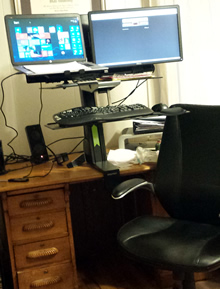 My adventure to find a way to stand more during the work day started at Office Depot. I purchased a rolling laptop cart, but it had to be assembled. When my husband got around to looking at it, he said he thought they had a better option at his office. A quick field trip to his office lead me to juststand.org. I needed something that would accommodate my laptop computer, a second screen, keyboard and mouse and have all these items connected, along with the printer and Internet cable. The rolling cart would have only allowed me to work on the laptop, while it was disconnected from my router. The employees in his office had these great workstations that had everything connected together. The product allowed them to easily move from sitting in their chair to standing and working effectively at their desk.
My adventure to find a way to stand more during the work day started at Office Depot. I purchased a rolling laptop cart, but it had to be assembled. When my husband got around to looking at it, he said he thought they had a better option at his office. A quick field trip to his office lead me to juststand.org. I needed something that would accommodate my laptop computer, a second screen, keyboard and mouse and have all these items connected, along with the printer and Internet cable. The rolling cart would have only allowed me to work on the laptop, while it was disconnected from my router. The employees in his office had these great workstations that had everything connected together. The product allowed them to easily move from sitting in their chair to standing and working effectively at their desk.
I purchase an Ergotron WorkFit-S, Dual Monitor Sit-Stand Workstation. We assembled and attached the work station to my antique oak desk. But, atlas, the laptop didn’t have a home! Follow-up to Amazon, netted an adaptor for the workstation that allows my laptop to set upon a perch that keeps it even with the second monitor. The overall fit to the antique desk is not perfect, but now I try to stand up more and sit less! I’m hoping that this change in my daily work environment will help reverse some of the medical factors I already have that are related to sitting too much.
Also, I'm thinking it will give my desk chair a break, as I noticed that it was kind of starting to slump to one side! This reminded me of a guy I worked with many years ago –he had sit in his chair for so long that it had distinctly conformed to his bottom! Others in the office would never bother his chair, as it didn’t feel right to anyone but him. Sometimes in networks that “conformed” condition can occur. If you retain a program and never make adjustments, update for the times, or evaluation – it may take on that feeling that it only works for certain members!
As we move from fall into the early winter months – let me know if you decide to try standing up more during the work day. If you find products that work for you, please share with me, so that we can share across NCHN. As Network Leaders, we should all be looking for ways to improve workplace productivity, which also improving our own health status and that of our members. Please join me in standing up on the job! And definitely send us photos of you doing so!
Rebecca J. Davis, Ph.D.
Executive Director
Featured Project: E-RHIT Network (Louisiana)

The Louisiana Rural Ambulance Alliance (LRAA), in partnership with the Louisiana Emergency Response Network (LERN) and the Louisiana Health Care Quality Forum (the state designated Health Information Exchange), established the Electronic-Rural Health Information Technology (E-RHIT) Network. Since its inception, the E-RHIT Network has expanded to include twenty three ambulance services and the Louisiana Traffic Records Coordinating Committee. Participation by LaHIE in the E-RHIT Network also expanded the footprint of the network to over 30 hospitals and 70 healthcare delivery facilities (physician offices, FQHCs, etc).
Louisiana is a very rural state, with approximately one-quarter of its residents residing in rural areas. As is true across the United States, rural Louisianans experience health disparities involving trauma. The E-RHIT network’s long-term goal is to integrate the LERN system with the HIE system and to share patient information across the continuum of care. To achieve this long-term goal, an initial and more immediate goal of the proposed project was the implementation of an Emergency Medical Service (EMS) Electronic 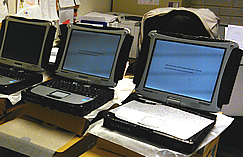 Patient Care Record that is compliant with National Emergency Medical Service Information System (NEMSIS) requirements. This goal has been accomplished. This Patient Care Record can now be shared with hospitals, specialists, and primary care providers for inclusion in their Electronic Health Records and utilized in meeting Meaningful Use standards. A secondary project goal was the population of a statewide trauma registry. This registry is now in use and continues to be the repository for real time and historical EMS trauma data. Analysis of trauma registry data can identify trends in mortality and morbidity necessitating additional training or a change in protocol.
Patient Care Record that is compliant with National Emergency Medical Service Information System (NEMSIS) requirements. This goal has been accomplished. This Patient Care Record can now be shared with hospitals, specialists, and primary care providers for inclusion in their Electronic Health Records and utilized in meeting Meaningful Use standards. A secondary project goal was the population of a statewide trauma registry. This registry is now in use and continues to be the repository for real time and historical EMS trauma data. Analysis of trauma registry data can identify trends in mortality and morbidity necessitating additional training or a change in protocol.
Description
E-RHIT is a network of ambulance services across Louisiana supporting the implementation and adoption of electronic Patient Care Reporting (ePCR). ePCR is used in these rural ambulances to document care given to patients at the time the care is provided and to record the type of incident. E-RHIT currently supports ePCR for ambulance services many of which are in very rural areas with limited cell phone reception. The software is installed in each ambulance on a ruggedized laptop that can connect to the state database via cellular network. The data collected consists of demographic, scene, and clinical information such as chief complaint and medications. Each service is also able to setup their own template and collect information that is relevant to their service area and local hospitals.
Data is feeding a centralized state reporting system. E-RHIT is participating in the state Health Information Exchange (HIE) and will be able to exchange information in real-time with hospitals and clinics in the future.
Services Offered
E-RHIT supports ambulance services throughout Louisiana with:
- Implementation and training of the ePCR application
- Support for custom template development
- Centralized data storage and first-level support
- Data collection
- Data analysis
- Hardware
- Software
Resources Used
In addition to grant funds awarded by HRSA Federal Office of Rural Health Policy, and generous in-kind donations from EMS services, funds were awarded by the National Traffic and Highway Safety Administration to expand the program to additional EMS providers.
Implementation
Goal 1: Formalize the E-RHIT Network
Objective 1: Establish Workgroups
Goal 2: Implement ImageTrend’s State Bridge software in order to create NEMSIS compliant and HIPAA compliant data sets and Electronic Patient Care Records
Objective 1: Develop agreements with the 40 rural pre-hospital provider organizations in the state to train their 2,500 emergency medical technicians on use of the ImageTrend product.
Objective 2: Increase knowledge about the benefits of and the ability to input data into a statewide EMS data collection system.
Goal 3: Create interoperability between Electronic Health Records (EHRs) used by Critical Access Hospitals and rural Federally Qualified Health Centers and EMS Patient Care Records
Objective 1: Identify certified EHR vendors used within the state which are amenable to development of interoperability with ImageTrend’s EMS Patient Care Record.
Objective 2: Create interoperability
Goal 4: Implement ImageTrend’s Patient Registry on Trauma, Stroke, ST-Segment Elevation Myocardial Infarction (STEMI), and Burn
Objective 1: Develop a process for extracting information from EMS Patient Care Records into the Patient Registry.
Goal 5: Use Continuous Quality Improvement Strategies
Objective 1: Solicit feedback from pre-hospital providers and network members
Objective 2: Analyze Patient Registry data
Objective 3: Hold training events for areas suggested by pre-hospital providers, network members and data
Goal 6: Disseminate Results of Program
Objective 1: Disseminate results to EMS providers
Objective 2: Disseminate results to other professionals, including health care providers and HIT specialists
Objective 3: Disseminate results to general public
Lessons Learned, Concerns, and Barriers
In the field and while in transport in the ambulance, the challenge is simply one of connectivity. As detailed above, much of Louisiana and the majority of the project sites are located in rural areas. Many of these rural areas do not have access to the internet. Paramedics can input data into the system while not connected to the internet, but the data cannot be transferred to a receiving facility until access to the internet can be established. This connectivity often does not happen until the transport is well underway.
The E-RHIT Network member discussions around data collection and analysis have focused primarily on two components; the challenges with timeliness and accuracy. While efforts to train end users on process to submit data timely and accurately continue, the members of the E-RHIT Network members recognize that there is some percentage of inaccurate data being submitted. To date, the Network members have not identified a way to determine what percent might be inaccurate and how to incorporate this potential inaccuracy into the analyzed data.
Results
- Successfully developing, adopting, and incorporating a National EMS Information System (NEMSIS) compliant data dictionary into the state EMS / Trauma system;
- Creating an EMS specific electronic health record template and making this template available to all EMS providers in the state while working with EMS providers to customize and incorporate a NEMSIS compliant template into their EMS Service;
- Awarding 120 rugged laptop computers to twenty three Louisiana licensed EMS Services and ensuring that this hardware was incorporated into their standard operating protocols and procedures. Specifically, these computers are used in the ambulances, on scene and in route, to capture patient data. The data is then transmitted to and incorporated into LERN, which is the statewide trauma registry, as well as to the EMS providers system to be used for patient care reports, billing, and quality improvement activities;
- Successfully facilitating the submission of data by EMS providers into LERN by training EMS professionals on this process. Prior to the formalization of the E-RHIT Network, only hospitals were submitting data into this registry; no EMS providers were submitting data. The submitted data is de-identified then analyzed to determine variations across communities in mortality and morbidity and used to inform training efforts; and
- Identifying gaps in the system as it relates to communicating and sharing patient data, patient outcomes, and morbidity.
As a result of the collection of data in real-time, more complete patient data is available to a broader spectrum of providers. The system has improved charge capture and inventory management for the rural ambulance services.
For the first time many of the ambulance services are collecting good data that can be used for process improvement. In addition, the collection of accident type data will be used to focus community education efforts. For example, if a large portion of ambulance calls are for ATV accidents, then community education on ATV safety can be provided.
Replication
By using a network to centralize the implementation and training of the ePCR system, E-RHIT was able to provide this valuable technology to man rural, volunteer ambulance services in Louisiana. This model could be replicated in many areas of the country.
Additional Information
While all of the accomplishments of the E-RHIT Network are significant, one certainly bears repeating. It is the accomplishment of identifying gaps in the system as they relate to communicating and sharing patient data, patient outcomes, and morbidity.
This accomplishment is the basis for the next stage of the E-RHIT Network. The next phase of the project will be to create a system to share patient information across the continuum of care. Specifically, access to LaHIE will allow EMS Practitioners, Paramedics and Basics, to access electronic patient data prior to or while conducting a transport on-scene at a: residence; motor vehicle accident (MVA); mass casualty event (MCE) hurricane / school shooting; physician office / FQHC/ RCH / nursing home; public facility (grocery store / football game / church); and in the Ambulance while in route to the most appropriate receiving facility. Additionally, creating access to the Hospital Dashboard will make electronic patient data available to the receiving health care facility.
For more information, contact:
Donna Newchurch
Executive Director
Louisiana Rural Ambulance Alliance
Ph: 985-513-3593
Email
Montana Health Network receives funding from three federal grants
 Montana Health Network (MHN) has received second round funding of its Navigator grant to place Health Insurance Navigators in rural Montana healthcare facilities. MHN has received $174,666 to train and continue to work of healthcare enrollment for uninsured Montanan’s. MHN will train 32 navigators in 29 facilities covering 32 counties. 23 Navigators are returning from last year. Additiona this year include Choteau, Jefferson, Deer Lodge and Powell counties.
Montana Health Network (MHN) has received second round funding of its Navigator grant to place Health Insurance Navigators in rural Montana healthcare facilities. MHN has received $174,666 to train and continue to work of healthcare enrollment for uninsured Montanan’s. MHN will train 32 navigators in 29 facilities covering 32 counties. 23 Navigators are returning from last year. Additiona this year include Choteau, Jefferson, Deer Lodge and Powell counties.
Montana Health Network has received Sub-contract funding from the Montana Office of Rural Health to open the North East Montana Area Health Education Center or NEMTAHEC. The amount of funding is $174,000 a year for the next six years to establish a strong healthcare education presence in eastern Montana. Montana Health Network already provided robust clinical educational offerings to hospitals in Montana and with the help of this grant will be able to expand services. NEMTAHEC’s services will expand to include:
- Continuation of providing on-site clinical education
- Establishment of a Mid-Level Provider Conference
- Provide subsidies for low cost R.E.A.C.H Camps (High School Healthcare Career Education)
- Provide a liaison between hospitals, schools and colleges to promote healthcare careers
- Provide support funding for students doing clinical rotations (Housing food and travel)
- Serve as a connection between NEMTAHEC region facilities and the placement of medical students
The focus of this initial grant will be on current and potential students in a healthcare related discipline. The grant will support one additional FTE in a school liaison/project coordination role.
Montana Health Network will receive sub-contract funding from the TAACCCT Department of Labor Grant. This grant will operate in the same region at the NEMTAHEC and will provide healthcare career support and guidance for displaced adult workers. The focus of this grant is geared more toward adults and attracting them to healthcare careers. This grant will add an additional 1.75 FTE’s to Montana Health Network in a job coaching and project coordinator role.
The purpose of this grant is to:
- Coordinate healthcare careers for displaced adult workers
- Coordinate healthcare careers between local/regional needs and regional colleges
- Perform labor analysis in the NEMTAHEC region
Montana Health Network has had a longstanding mission to Attract, Recruit, Retain and Educate the Healthcare workforce in the communities it serves. These three grants will help tremendously in creating healthcare awareness and helping to address the current healthcare labor shortage in the region.
For more information, contact:
Chris Hopkins
chopkins@montanahealthnetwork.com
www.montanahealthnetwork.com
Chairs of Network Leadership: Part II (From the Executive Director, September 2014)

Chairs, Chairs, Chairs – we all use them every day! Did anyone besides Mary Ann Watson, Tennessee Rural Partners, think about the chairs in your network? Mary Ann said that she was going to propose a “chair inventory” around their network! I am curious to see if anyone else conducted a “chair inventory.” Did you find any programs in need of discarding, re-branding and/or reviving, or maybe even ready to be passed off to another organization to manage? Tell us about your chair inventory. If you didn’t see Mary Ann’s response to my article last month, you can read it here.
I must confess, I bought another chair. My plan with this series on Chairs and how they relate to Network Leadership was to start with the first chair I purchased, way back in the early 1970s! But then I bought this chair and thought, hmmm, maybe it makes more sense to start here and work backwards.
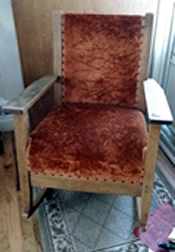 So, please meet my newest chair! See? It is a nice sturdy vintage oak rocker! Did I need it? No, but it was one of those deals that was just too good to pass up! I was at a live auction a couple of Saturdays ago and this chair, made by Grand Rapids Bookcase & Chair Company came up for sale. It reminded me of “mission oak” furniture and another similar, (non-rocker) chair I had bought in Virginia a few years ago. (And yes, I still have that chair.) So, when no one would bid on this rocker, I started it at $5.00. The auctioneer promptly got a $10.00 bid, but then no more bids seemed forthcoming. Could this antique oak rocker really sell for just $10.00? I just couldn’t image such a criminal thing happening to the chair, so I bid $15.00, thinking now someone else will surely see the value in this chair and continue bidding. Seems that no one else saw the value of the chair and I would become its new owner.
So, please meet my newest chair! See? It is a nice sturdy vintage oak rocker! Did I need it? No, but it was one of those deals that was just too good to pass up! I was at a live auction a couple of Saturdays ago and this chair, made by Grand Rapids Bookcase & Chair Company came up for sale. It reminded me of “mission oak” furniture and another similar, (non-rocker) chair I had bought in Virginia a few years ago. (And yes, I still have that chair.) So, when no one would bid on this rocker, I started it at $5.00. The auctioneer promptly got a $10.00 bid, but then no more bids seemed forthcoming. Could this antique oak rocker really sell for just $10.00? I just couldn’t image such a criminal thing happening to the chair, so I bid $15.00, thinking now someone else will surely see the value in this chair and continue bidding. Seems that no one else saw the value of the chair and I would become its new owner.
So, fast forward to later in the morning when Michael, my husband came back to check on me and how things were going and I introduced him to our new chair. First question, “Do we need this chair?” Of course not, but could I let it go for just a mere $10.00? I don’t think so! Do not worry, we will find a use for it or a new home. So far, it is still sitting just inside our front door. I haven’t found a home for it in our house and I'm still thinking about what I am going to do with this chair?!
This chair will represent “Durability” in our leadership series. It is durable, sturdy, heavy, well-constructed, dependable, and was very cost effective! Do you find yourself considering potential new programs or services for your network that seem like such a great value that you can’t pass them up? I bet you do. But will your members appreciate your great savings? Will they participate in the program or purchase the service from the network? Do you need a program or product that is similar to one you already have? Maybe you even have a few similar programs or products that members are not taking advantage of or currently using. If so, could a new program spark some interest?
Sometimes it just takes a little bit of a different look to get someone’s attention. Sometimes it can be something that your members are already familiar with, but maybe not used. Sometimes we just have to try another style of bringing services, products, or items to our members. In this eNews you will read about a new project that NCHN just released, our “Tools and Strategies for Managing Health Networks” website. We are so excited about this resource and thank all the members over the years that have answered questions, submitted examples and templates, and provided resources and support to their peers! Now you can find those items in one place.
Why don’t you pull up a chair and take a few minute and review the new site? And while you are doing so, let us know what you think. We would love some feedback on the website - what’s missing, what’s great, what would make it more usable, anything you can tell us to make the site the best resource for health networks – tell us.
Let us hear from you! Tell us about your newest “chair” (program). I’m sure other network leaders would like to know what their peers are doing and this is a great platform to share! Especially those of you that have received a recent HRSA grant. Tell us about the new program or service you will be launching.
And, by the way, would anyone be interested in a good vintage oak rocker? I have one looking for a home!
Rebecca J. Davis, Ph.D.
Executive Director
MiREMS Receives RAED Grant Funds
 Michigan Rural EMS Network's MiResCu program, in partnership with UP EMS and Mike Helbock (Seattle/King County, WA), has been awarded a Rural Access to Emergency Devices grant throught HRSA's Office of Rural Health Policy. The award provides for $150,000/year for 3 years. The project start date is September 1, 2014.
Michigan Rural EMS Network's MiResCu program, in partnership with UP EMS and Mike Helbock (Seattle/King County, WA), has been awarded a Rural Access to Emergency Devices grant throught HRSA's Office of Rural Health Policy. The award provides for $150,000/year for 3 years. The project start date is September 1, 2014.
RAED grant funds will be used to place 120 AEDS (40 per year) in communities in rural Michigan. All AED placements will be accompanied by CPR training that meets American Heart Association guidelines. The MiRESCU CPR training model incorporates the Seattle/King County Resuscitation Academy’s signature High-Performance CPR (HP-CPR) programMiResCu will provide technical assistance to communities receiving AEDs. Assistance will be provided for community education, program implementation, and data reporting to the CARES cariac registry. Project goals include:
- Placement of AEDs in 30-40 rural communities that are most appropriate and in need;
- Provision of training to healthcare providers, dispatch staff, law enforcement officers, and residents in communities identified for AED placement;
- Data collection and submission in all communities identified for AED placement; and
- Evaluation of the use of AEDs through data submitted to the CARES registry.
MiREMS has been awarded $776,245 from the Office of Rural Health Policy since 2011. A list of all RAED awardees can be found here: http://datawarehouse.hrsa.gov/Tools/FindGrants.aspx
From the Executive Director: Chairs of Network Leadership (August 2014)
 August. Summer vacations are coming to an end, kids are getting ready, or have already, started back to school, mornings feel cooler, afternoons are hot, and we start thinking about fall activities. Does your network have an ebb and flow cycle? Do you offer certain activities or conduct certain functions in the fall? Why don’t you share with your peers across the country some of the fall activities of your network? We would love to hear from you, just send a short description of the activity/event to me or Christy and we will feature them in future issues of the e-News!
August. Summer vacations are coming to an end, kids are getting ready, or have already, started back to school, mornings feel cooler, afternoons are hot, and we start thinking about fall activities. Does your network have an ebb and flow cycle? Do you offer certain activities or conduct certain functions in the fall? Why don’t you share with your peers across the country some of the fall activities of your network? We would love to hear from you, just send a short description of the activity/event to me or Christy and we will feature them in future issues of the e-News!
NCHN has traditionally held our Leadership Summit in the fall. This year we are changing it to January 2015 and are in the final stages of deciding on a location. We are looking for someplace warm in January and possibility with a beach! So, watch for more details in the September e-News.
This month, we also welcome a new member, Washington Rural Health Collaborative. Holly Greenwood is the Executive Director. We welcome her and the network to NCHN.
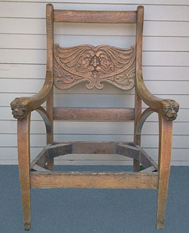 I am going to start a series, Chairs of Network Leadership. If I put it here, then I’m committed to doing it! Last week, I purchased an antique wicker chair at the Hospices parking lot sale here in Montrose. In telling Christy about the purchase, I made the comment that we were really “chair poor” meaning that we had a lot of chairs. That got me to thinking about how many chairs I actually do have, and on my preliminary count I was close to 60 chairs. Now, by chairs, I’m talking about a single chair, including recliners, rocking chairs, dining room chairs, lounge chairs, outdoor chairs, etc. I am going to take an inventory and address this potential chair issue I may have uncovered! Christy suggested I start a blog about my chairs, as I told her most every chair had a story. So, then I started thinking, why and how have I ended up with so many chairs in my life? What do they or could they reveal about me? Maybe not a thing, just that I have a compulsion of purchasing chairs? I will admit in this “thinking about writing about a chair series” rambling that I decided that I should probably begin to address the chair issue. So, the next day I took a chair and donated it to Hospices. I told the lady that I decided I needed to take one out, since I had brought a new one home the day before. She said that worked for them!
I am going to start a series, Chairs of Network Leadership. If I put it here, then I’m committed to doing it! Last week, I purchased an antique wicker chair at the Hospices parking lot sale here in Montrose. In telling Christy about the purchase, I made the comment that we were really “chair poor” meaning that we had a lot of chairs. That got me to thinking about how many chairs I actually do have, and on my preliminary count I was close to 60 chairs. Now, by chairs, I’m talking about a single chair, including recliners, rocking chairs, dining room chairs, lounge chairs, outdoor chairs, etc. I am going to take an inventory and address this potential chair issue I may have uncovered! Christy suggested I start a blog about my chairs, as I told her most every chair had a story. So, then I started thinking, why and how have I ended up with so many chairs in my life? What do they or could they reveal about me? Maybe not a thing, just that I have a compulsion of purchasing chairs? I will admit in this “thinking about writing about a chair series” rambling that I decided that I should probably begin to address the chair issue. So, the next day I took a chair and donated it to Hospices. I told the lady that I decided I needed to take one out, since I had brought a new one home the day before. She said that worked for them!
So, I challenge you this next month, as we begin to move into fall, think about “chairs” you may have in your network. Do you seem to collect the same type of
programs and services? When you start a new program, do you consider using it as a replacement to a similar program or service? Or do you just keep adding new programs and allowing older ones that may not be as effective or useful to hang around? Have you taken inventory of what your network offers recently and analyzed the offerings to determine if they are the best fits for your members. Will the programs and services change and develop as the needs of your members change? Have you counted your chairs lately?
Rebecca J. Davis, Ph.D.
Executive Director
Community Health Worker Training Program (Northeast Oregon Network)
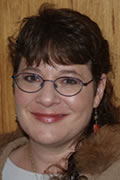
Lisa Ladendorff is Executive Director of Northeast Oregon Network
Community Health Worker Training Program (Northeast Oregon Network)
Program Description
In 2012, the State of Oregon established Traditional Health Worker certification legislation the created a scope of work, competencies and certification pathway for Community Health Workers, Peer Mentors, Doulas, Promaturas and other traditional health worker roles. The legislation also established a pathway for community based entities to become state approved training programs. The Northeast Oregon Network was the second certified training program in the State of Oregon, and the only one to focus specifically on the training of rural and frontier individuals. Upon completion of the NEON 80 hour training program, which utilizes popular education methods to train individuals in the Community Health Worker history, role, scope and skills, an individual is eligible for certification in the state of Oregon. NEON also runs an ongoing Community of Practice for all individuals completing the training program, and their employing organization. The intent of the Community of Practice is to continue to provide support to newly trained CHWs, to assist organizations in integrating this new workforce into their already existing work flows, provide ongoing training, and create a grassroots advocacy movement for health system transformation in rural areas.
Resources Used
The NEON Community Health Worker Training Program was created with resources from a Centers for Disease Control and Prevention Small Community Transformation Grant, and with the support of the PacificSource Foundation in Oregon. NEON worked with Portland, Oregon area consultants, the Multnomah County Community Capacitation Center, on licensing their training curriculum and training NEON's trainers. NEON has one full time staff person dedicated to coordinating the program and serving as the lead trainer, with two other NEON staff providing teaching expertise during training sessions. NEON also has staff support dedicated to supporting the virtual community of practice website, and in staffing community of practice meetings and ongoing trainings. Eastern Oregon University, a local regional State University, has provided free classroom space and the opportunity for students to take the CHW training series for college credit. Local content expert professionals volunteer time to provide segments of training on areas in their content expertise.
Implementation
NEON started the training program development by an in depth review of the enabling legislation and corresponding Administrative Rules in order to understand in depth the certification requirements. The NEON Training Program Coordinator was also appointed to the State Traditional Health Worker Commission, which placed NEON in the position of shaping policy as it was developed and assisted us in developing an in depth understanding of the new requirements. Our next step was to contract with the Community Capacitation Center to revise and adapt their curriculum to a frontier setting, and to complete an initial training that trained and certified NEON staff as approved trainers for the curriculum.
NEON staff spent a great deal of time educating the local partners on the new Community Health Worker workforce, creating an understanding of how this new role could fit into early childhood education, primary care clinic, behavioral health and social service settings. We focused on recruiting and training already employed staff in partner organizations, with the intent of retraining and retooling the existing workforce, so that they would be well positioned to receive reimbursement from insurance payers for CHW services, once payers had determined how to do so. Although the training was provided at no tuition cost, the employing organizations were asked to give staff paid release time to attend the training, and the trainee and the organization had to sign an agreement agreeing to basic data collection for two years post training, and agree to participation in the Community of Practice, in order to access the training.
The Community of Practice involves two components; a virtual community supported through a basecamp software set up, and in person quarterly meetings and trainings. One individuals complete the CHW training, they are registered in the base camp community, and invited to all quarterly meetings and trainings. NEON staff is also available to work with each employing organization and CHW in focused integration of the CHW into the partner's work flow processes.
Currently the program is focused on creating ongoing sustainability, though marketing of the training program in the surrounding areas and states. NEON focuses specifically on rural and frontier training, and hopes to develop a market for providing the training nationally to other rural/frontier areas. NEON is also focusing sustainability on providing consulting services to any sites wanting to develop their own training programs.
Lessons Learned
One of the lessons learned has been that the success of the training program will depend heavily upon the partnerships that already exist with the training agency, and that a significant amount of "selling" organizations on the CHW model is necessary in order for people to support the training program. Ongoing, consistent contact with the partners and employing organizations is a vital part of the success o the programs, as this is not just a training program, but a vital community resource intimately connected to supporting health care transformation activities in our rural area. While some partners will be ready for health care transformation activities, others will be slower to adopt and adjust, mainly due to concerns about long term revenue impact of the model on their bottom line.
It is helpful for community based entities trying to establish a program to connect and partner with an entity that has an already developed curriculum, as the demands of establishing a community based program and the demands of developing a curriculum are probably too large for a rural entity to tackle at the same time. It also helps to navigate approval and licensing processes if the curriculum being used is an already acknowledged curriculum in good standing with program regulators.
NEON has continued to support a Community of Practice, as it is our experience that this element is just as, if not more important than, the actual training in terms of effecting real change in the health and social services environment. People and organizations need to be supported after the training in order to navigate the integration into systems that will need to take place.
Outcomes
To date the NEON program has trained held three training session, with 45 CHWs trained and four certified trainers. 38 of these individuals, or 84%, of those trained are working in a practice setting, and are already impacting the provision of services. These 38 CHWs have served over 500 individuals in the last year alone with over 1,200 episodes of care. NEON is currently working developing a return on investment analysis for an estimate of health care dollars saved and health outcomes improved, and has received a $150,000 foundation grant from the Meyer Memorial Trust to conduct this evaluation. The results of this evaluation will be used to advocate with Medicaid and third party insurance payers to develop a reimbursement mechanism for ongoing support of CHW services. 29 individuals, or 64%, continue to be involved in the Community of Practice one year post training.
More Information
For more information on the program and for questions regarding NEON resources related to this topic, please contact either Lisa Ladendorff, Executive Director at lladendorff@neonoregon.org or Pepper McColgan, CHW Training Program Coordinator at pmccolgan@neonoregon.org.
Featured Member: Karen Nichols, Executive Director of Upper Midlands Rural Health Network
 Karen Nichols became the Executive Director for the Upper Midlands Rural Health Network (UMRHN) in June 2014. UMRHN is a 501(c)(3) founded in 2004 with a mission to improve health in Chester and Fairfield counties in South Carolina through a collaboration of a diverse group of agencies focused on access to care, health promotion, and education.
Karen Nichols became the Executive Director for the Upper Midlands Rural Health Network (UMRHN) in June 2014. UMRHN is a 501(c)(3) founded in 2004 with a mission to improve health in Chester and Fairfield counties in South Carolina through a collaboration of a diverse group of agencies focused on access to care, health promotion, and education.
Prior to accepting this position, Karen served for six years as the Economic Development Director for a Federally recognized Indian Tribe, the Catawba Indian Nation. In this role, she developed strategies and programs to enable the Tribe to position itself for economic growth. She managed two Federal contracts with the Bureau of Indian Affairs totaling $400,000 which established a vocational training program and an entrepreneurship program. She also brought in seven additional grants totaling over $1.2 million to establish programs such as financial education, teen dropout prevention, residential weatherization, land acquisition, photovoltaics, and a revolving loan program. Before working for the Tribe, Karen spent eight years in the marketing department of the North Carolina’s largest gated tourist attraction. In this capacity, she worked in all aspects of marketing, including website development, promotions, group sales, public relations, and customer-loyalty programs.
Prior to moving to the Carolinas, Karen worked for six years at her alma mater, Virginia Tech. In her first role, she worked with county economic development officers, local elected officials, manufacturers, and the professors to leverage the knowledge and research at the university for the purpose of economic growth. Her second position was with the College of Engineering in a major-gift fundraising capacity. Karen participated in a $50-million university-wide campaign soliciting gifts of $25,000 or more from individuals, corporations, and private foundations. Karen earned a B.A and an MBA from Virginia Tech.
From the Executive Director: The Dog Days of Network Leadership
 July. Here we are in the middle of summer! Are you stopping to enjoy the season, stopping to smell the flowers, have you been to or plan to visit a state or national park, had a picnic, visited friends, been swimming, hiking, or any other summertime activity that would be great to help you recharge your batteries?
July. Here we are in the middle of summer! Are you stopping to enjoy the season, stopping to smell the flowers, have you been to or plan to visit a state or national park, had a picnic, visited friends, been swimming, hiking, or any other summertime activity that would be great to help you recharge your batteries?
Yesterday, as I was working on my article, I decided to unplug from the Internet. I actually took the computer to the back porch, thinking I could give the “girls” (pictured right: Hattie, Lacey, and Millie) some extra time in the back yard shade and also get some work done. I have thought about doing this several times, but just never followed through on that thought.
It was later in the afternoon and around 91 degrees. As I got all set up to work, I was thinking, “Man, it is a lot cooler in the office with the swamp cooler running than it is out here in this heat!” But, soon I was distracted by what was going on around me. Our “girls,” which many of you may know are our two dogs, Hattie and Lacey, have now expanded to three girls. We are dog sitting Ms. Millie, our son Logan’s dog. Millie has been with us since Memorial Day weekend. She spent about a year and half with us back in 2010-2011, so the “girls” had been together before, but we have been going through a bit of an adjustment period.
Millie has a lot of energy and likes to run and play. Hattie and Lacey have grown to 139 pounds each, and they seem to like to just lay in the shade and watch Millie’s activities. Today, Hattie decided that she might also like to play - just a little bit - so the game consisted of Millie running and jumping at Hattie, Hattie making a half-hearted effort to engage with Millie, which led to either some dog-play biting activities between the two dogs, or Millie taking her daily running fit around the yard. That girl is a zoomer! She will run as fast as she can from one side of the yard to the other and during each lap she will take a jump at Hattie, almost like, "Hey, catch me if you can!" Then she ends the run by racing to the little evergreen bush, jumping underneath it, and digging like she is onto gold!
Sometimes I think network leaders are a lot like that – running around trying to meet the needs of their members, tempting network members to become more engaged, searching for services or products, or developing them to assist their members.
Also, while sitting on the back porch, I was buzzed by a hummingbird. I guess it thought my red head might be a food spot. That would have never happened if I had stayed in the office. I also got to listen to a dove that seems to live around the back yard. Today, it had a lot of singing to do. And I listened to Lacey, our barker. I really think Lacey would explode if she couldn’t bark – she barked at the dove, she barked at the kids we could hear walking in the alley, she barked at the cars that went by, she barked at the sky. Do you have a barker in your network? Someone that always needs attention and may be overshadowing the voices and needs of your other members?
I’m sure to the folks that happened on the other side of our 8 foot privacy fence they wondered what kind of strange animals live on the other side.
Barking Lacey and a woman constantly saying, “Lacey, no bark, Lacey, no bark … Good Lacey.” “Millie, no dig, aww... good Millie.” As I reflected on the day, I realized that Lacey commanded the majority of my attention. Millie came in second when she became too excited during the dog-biting playing activities and each time she dove under the bush and started digging! And sweet Hattie, she was just kind of there... I knew she was there, but she really didn’t demand any attention until right before I decided to retreat to the coolness of the office. It seemed that Lacey and Hattie had changed positions. Lacey was laying in the shade looking around and Hattie had taken up the barking duties! Did they just do this, or did Hattie decide she wanted some of my attention?
I thought about you, the NCHN members. We don’t get to see you on a regular basis. Do we accommodate your needs? Do we give you enough attention? Do we focus on the ones we hear from the most – and we do love hearing from the members! Or do we just react to the dive boomer – like I reacted to that hummingbird?

Everyone is busy and here at NCHN, we want to be busy doing the correct activities, finding and engaging the best partners, providing outstanding programming that meets your needs. So, as you take time to enjoy the summer days, also take a few minutes to think about NCHN, your organization, and let us know if there is something that we could be doing to support you! We love to accommodate our members!
Rebecca J. Davis, Ph.D.
Executive Director
Cindy Siler recognized as 2014 Outstanding Health Network Leader
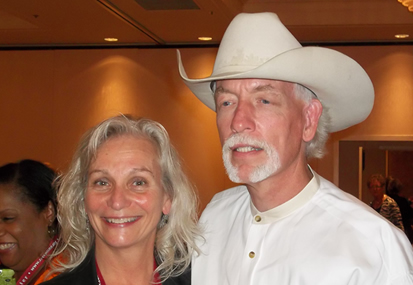 Cindy Siler (Brentwood, Tennessee) -- 2014 NCHN Outstanding Health Network Leader (pictured right, with husband)
Cindy Siler (Brentwood, Tennessee) -- 2014 NCHN Outstanding Health Network Leader (pictured right, with husband)
The National Cooperative of Health Networks Association (NCHN) announced the 6th national award winners during its 2014 Annual Educational Conference in St. Louis, Missouri last month. Cindy Siler, Deputy Director of Tennessee Rural Partnership, was selected as the recipient of the 2014 NCHN Outstanding Network Leader. NCHN is a membership organization comprised of health network leaders from throughout the nation. The Outstanding Network Leader Award recognizes a network leader with at least five (5) years of experience for leadership in managing a successful health network organization.
Tennessee Rural Partnership (TRP) was incorporated in 2005 to serve the state by assisting in recruitment and retention of physicians and other health professionals. Since 2006, under Siler’s leadership, TRP has provided invaluable services to the rural areas of the state. TRP has placed 81 clinicians serving over 200,000 patients throughout the state and has implemented over 40 rural rotations. Its Stipend Incentive Program has given over $7.7 million to rural Tennessee.
Siler serves on the NCHN Board of Directors and is Chair of the Membership Task Force, a member of the 2013 Leadership Learning Community and an active and frequent participant on NCHN Coffee/Tea Chats. TRP recently underwent a major reorganization, moving from an independent organization to forming a partnership with the Tennessee Hospital Association. “Her expertise in handling this transition was one of the reasons that she was nominated for this award,” said Rebecca Davis, Executive Director of NCHN. “Cindy managed to keep the core mission of TRP intact and protected, while supporting staff during the transition. She is an active participant in membership calls and activities, and her willingness to share her growth experience with other network directors and support her peers while dealing with her network’s transition are shining indicators of her keen leadership abilities.” She continues to grow in her dual role, as a Deputy Director in the Hospital Association’s organizational chart, assuming duties related to that position, while serving as the TRP’s Director.
“Cindy is a champion of healthcare for the rural and underserved in Tennessee,” continued Dr. Davis. “Everything she does comes back to the goal of expanding primary care access to the most vulnerable populations. She is a tireless advocate for this mission, and her lifetime of service reflects her dedication.” During her career in the non-profit healthcare industry, Siler has served on numerous boards and led community activities. She has been the Board President of both the Tennessee Primary Care Association and the Rural Health Association of Tennessee. In 2013, she was awarded the Eloise Hatmaker Distinguished Service Award by The Rural Health Association of Tennessee.
NCHN is a professional membership organization of health network leaders across the nation. Its mission is to support and strengthen health networks through collaboration, networking, leadership development and education. The Association has members in 31 states. By definition, health networks are formed when three or more health care providers formally come together to better meet the needs of patients in their service area. These providers often include hospitals, community health centers, critical access hospitals, physician practices, mental health providers, rural health clinics and other for-profit and not-for-profit health care organizations. The networks strive to increase access to quality health care for local patients and streamline the cost of that care. For more information please go to www.nchn.org.
